This post may contain affiliate links. Please read our disclosure policy.
Learn how to make fermented tofu, also called “Chao,” from scratch! This 4-ingredient condiment is cheesy and tangy and can be used to add plenty of flavor to soups, marinades, dipping sauces, and more!
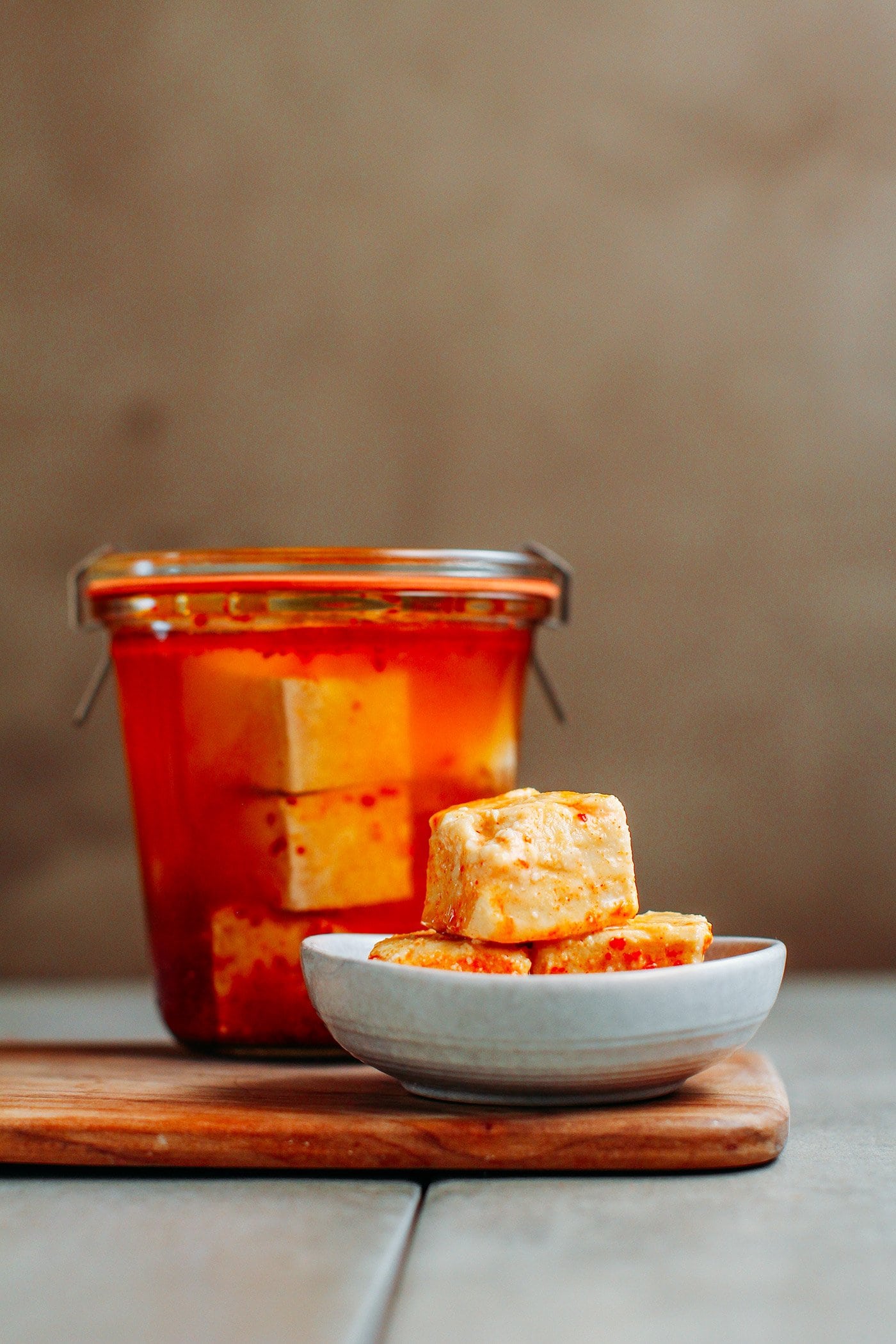
Since discovering fermented tofu, I have been using it a lot. Whether it is in soups, marinades, or as a dipping sauce, it can be used in many dishes to add extra flavor, umami, and some cheesiness.
The thing is, fermented tofu is not that easy to find, and let’s be honest, I wanted to learn how to make my own. Here is a guide on how to make fermented tofu (also called Chao) from scratch!
📘 What is Chao?
Chao (which is its Vietnamese name) is tofu that is fermented for at least 1 month in a brine that consists of water, salt, and usually rice wine. According to some books, the technique of making fermented tofu appeared in 200 BC in China.
It is quite salty, sometimes spicy, and has a very soft texture, almost like a paste that you could compare to blue cheese. When Chao is fermented for a long time, it takes a strong flavor, which reminds me of a strong camembert.
What’s great about chao is that it keeps for months, if not years, in its brine!
🥣 How to Make Fermented Tofu (Chao)?
Making chao is easy but requires some patience!
Before starting: As with most fermented recipes, taking care of hygiene is critical to the success of the fermentation process. So I recommend using gloves while handling the tofu to prevent bad bacteria.
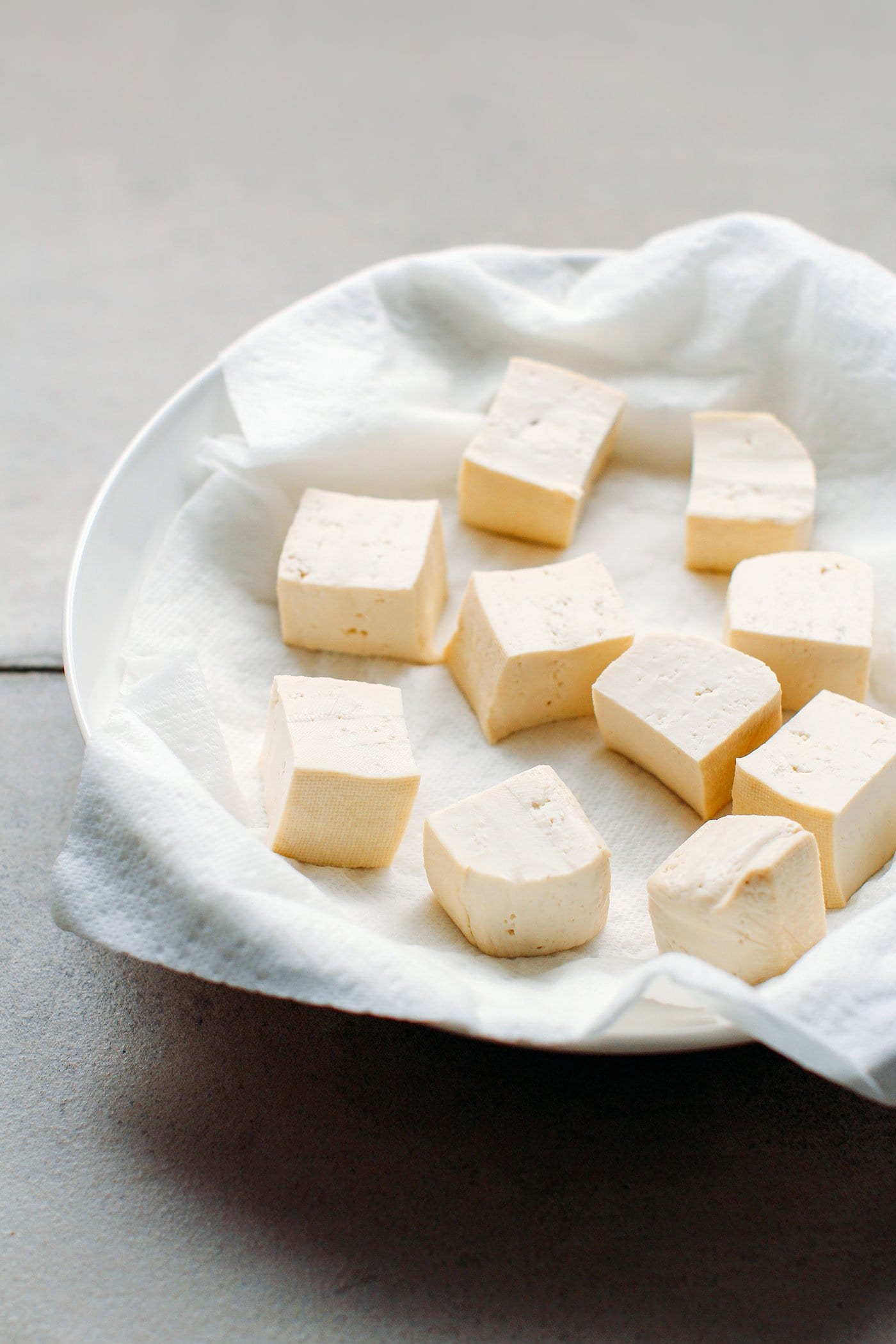
Preparing the tofu
It starts with the tofu that is boiled for a couple of minutes in salted water. This step not only helps kill some bacteria but also helps the tofu drain more water.
Next, you want to place your tofu on several sheets of kitchen paper towel, cover it with more paper towels, and place a weight on it to press it and remove excess water. I usually use a large iron skillet that is quite heavy. Leave your tofu like this for about 1 and a half hours, and change the paper towel as needed if it becomes too wet.
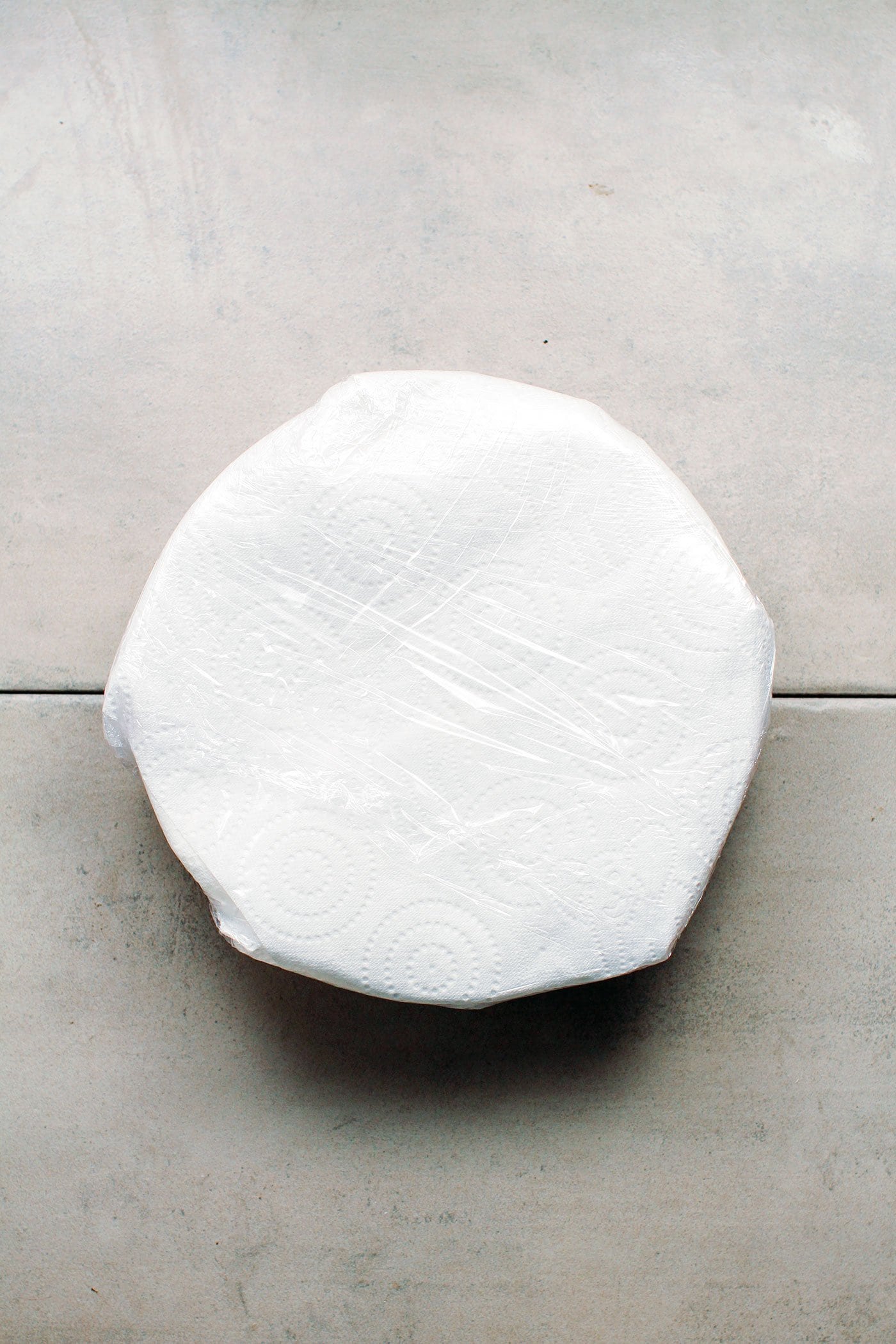
Fermentation
Next, cut your tofu into 1-inch cubes. Place them on a plate lined with a kitchen paper towel, then place another piece of paper towel on top and cover the whole plate with plastic film.
Now you want to let the tofu ferment for about 2 days at 77-86°F (25-30° Celcius). So as you can guess, this recipe works best in the summer, but it can also be done during winter if you have a warm spot in your house.
After 2-3 days, the tofu should be slightly orange and a bit stinky (see photo below). It may have some white mold as well; that’s okay. If you see black or blue mold, just scrape it off. A quick tip: if the tofu is not stinky enough when you put it in the brine, you will end up with a mild chao. If it is already stinky, your chao will be stronger.
The hardest part is now done!
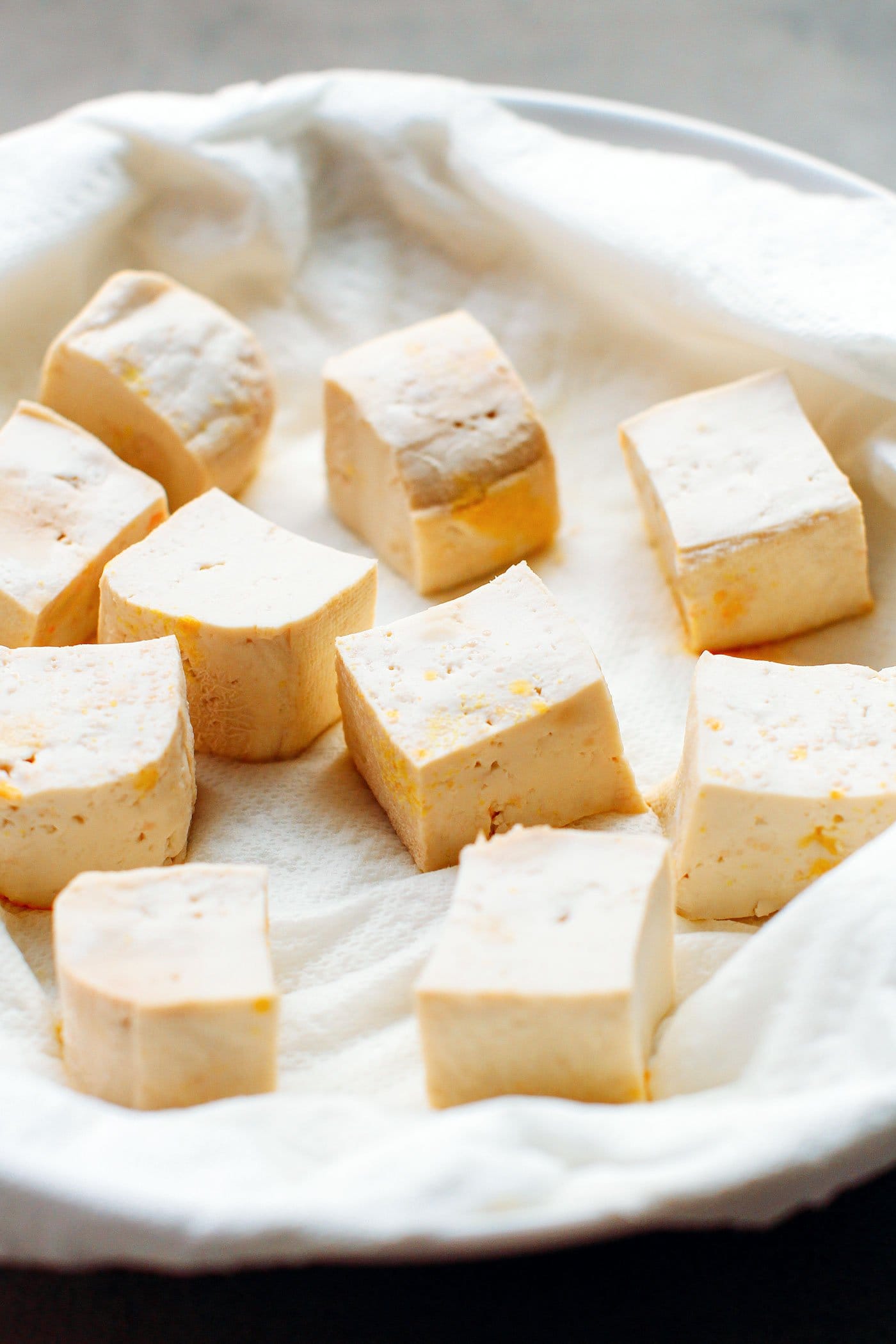
Adding to the Brine
The tofu now contains some natural cultures and molds that will work during the fermentation process.
To prevent the tofu from going bad, we need a brine. It consists of boiled water mixed with salt, sugar, and rice wine (or vodka). Place the tofu cubes in glass jars and cover with the brine.
Optionally, you can dip each tofu cube in chili flakes. It makes the chao more flavorful and gives it an appealing orange color. If you plan on using chao to make cheeses, simply omit the chili.
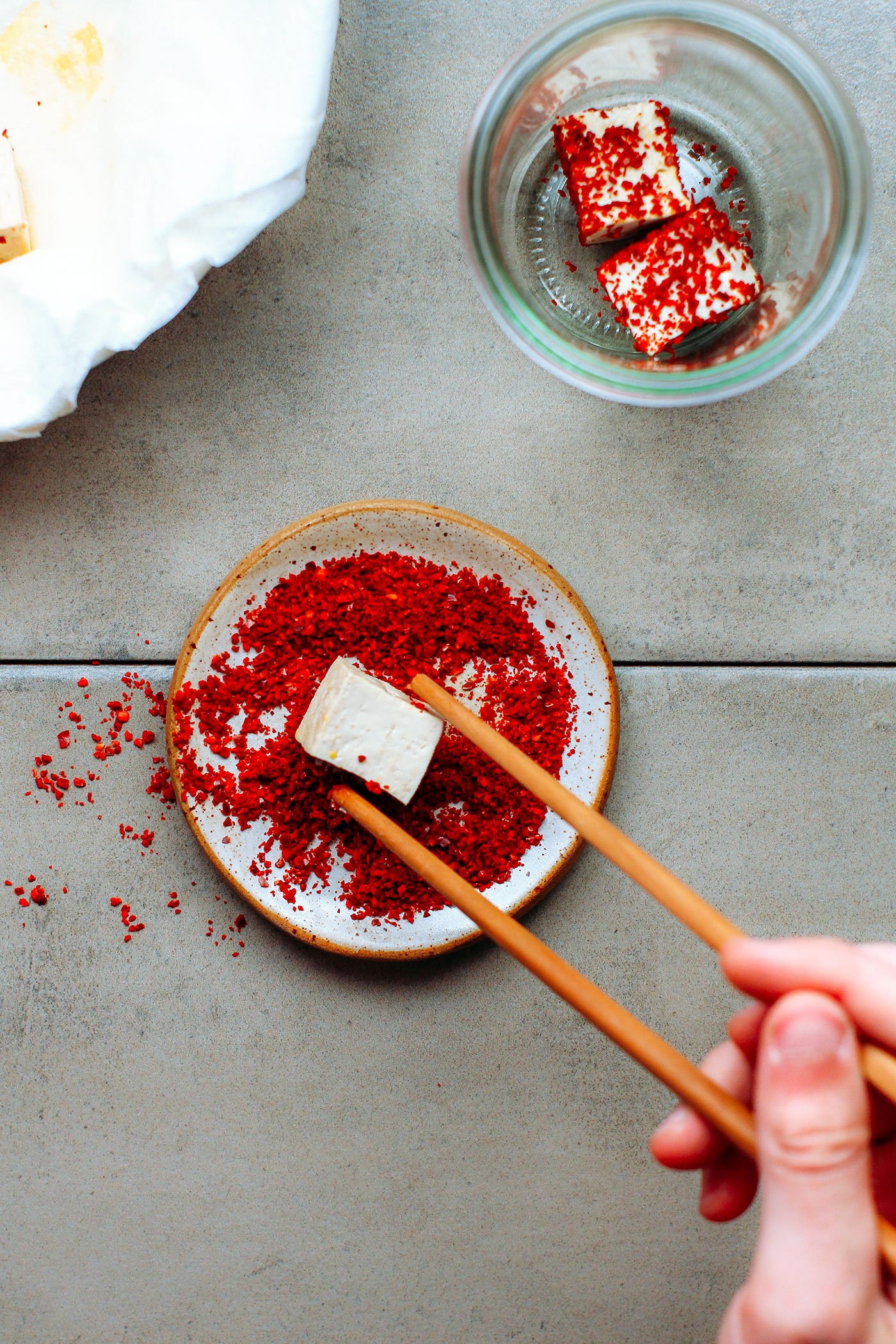
Once your jars are filled, secure them with a lid and place them in a dark place at around 68°F (20°C) for at least 3 weeks.
The longer you let it age, the stronger and softer it becomes. I found that after 6 weeks, the tofu was already creamy and had a nice cheese flavor.
💬 FAQ
I would not recommend it. It helps with the preservation of the tofu.
No, you shouldn’t have any black mold. If that is the case, start again and make sure all of your tools and plates are clean. Use very clean hands while handling the tofu, or handle it with clean chopsticks.
You can keep chao in your refrigerator for up to a year. I personally had a jar that I kept for over a year, and the chao was still perfectly good!
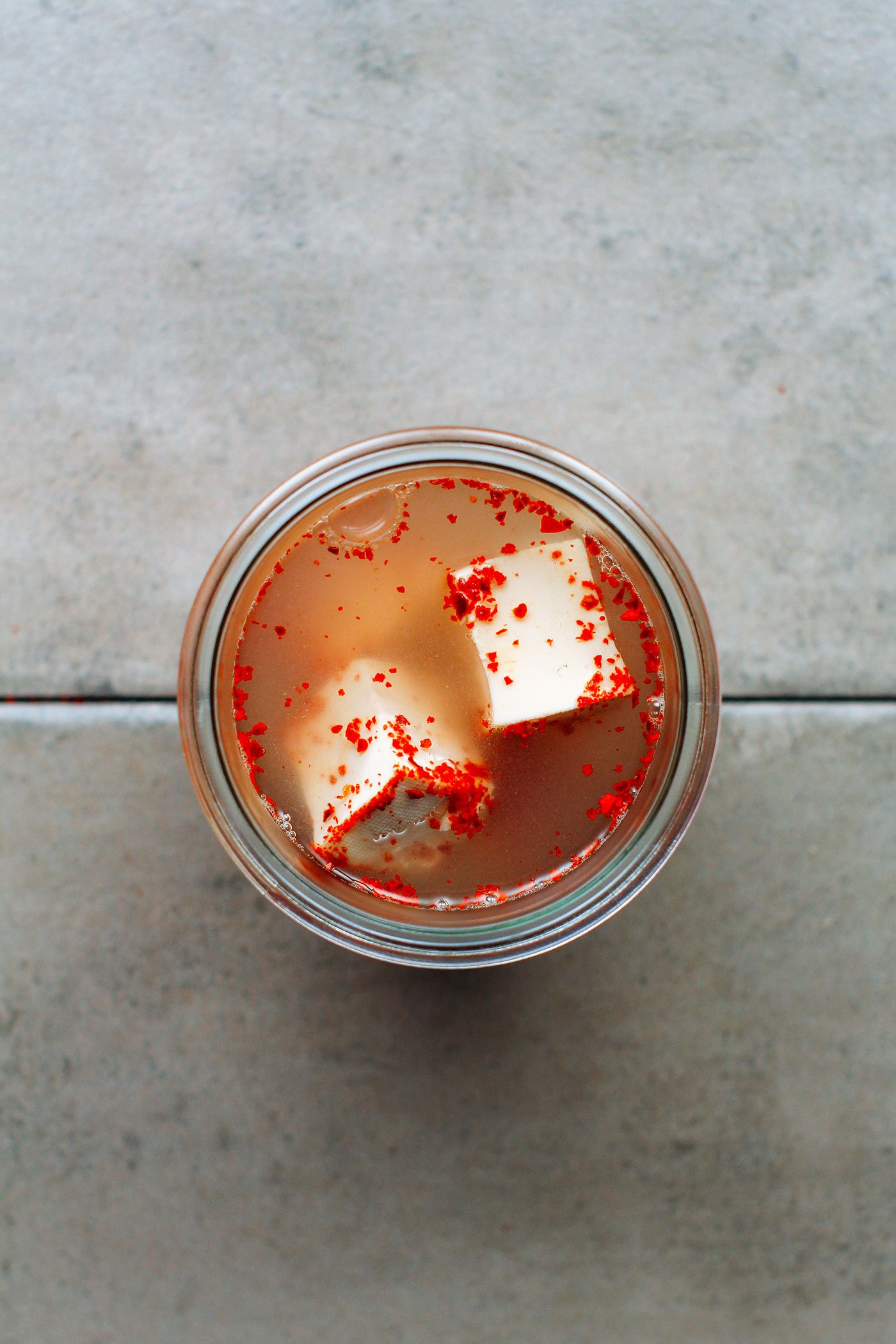
🥢 How to Use Chao?
Chao can be used in a handful of ways:
- Dipping sauces: Mash a cube of chao and mix it with some lime juice, sugar, chili, and a little bit of water to dilute. The sauce can then be used as a dipping sauce for steamed veggies.
- Vegan cheeses: Since chao is packed with umami and cheesiness, it’s perfect to add flavor to your vegan cheeses! Add half of a cube to vegan camembert or smoked cheese when blending the cashews for a deeper flavor!
- On top of rice: Add some chao on top of steamed white rice and slightly mash it using chopsticks. Chao will add saltiness and cheesiness!
- Stirred into soups: Perfect to take your soups to the next level, you can use it in place of miso.
- Marinades: Combined with soy sauce, sugar, and sesame oil, this fermented tofu can be used as a base for marinades.
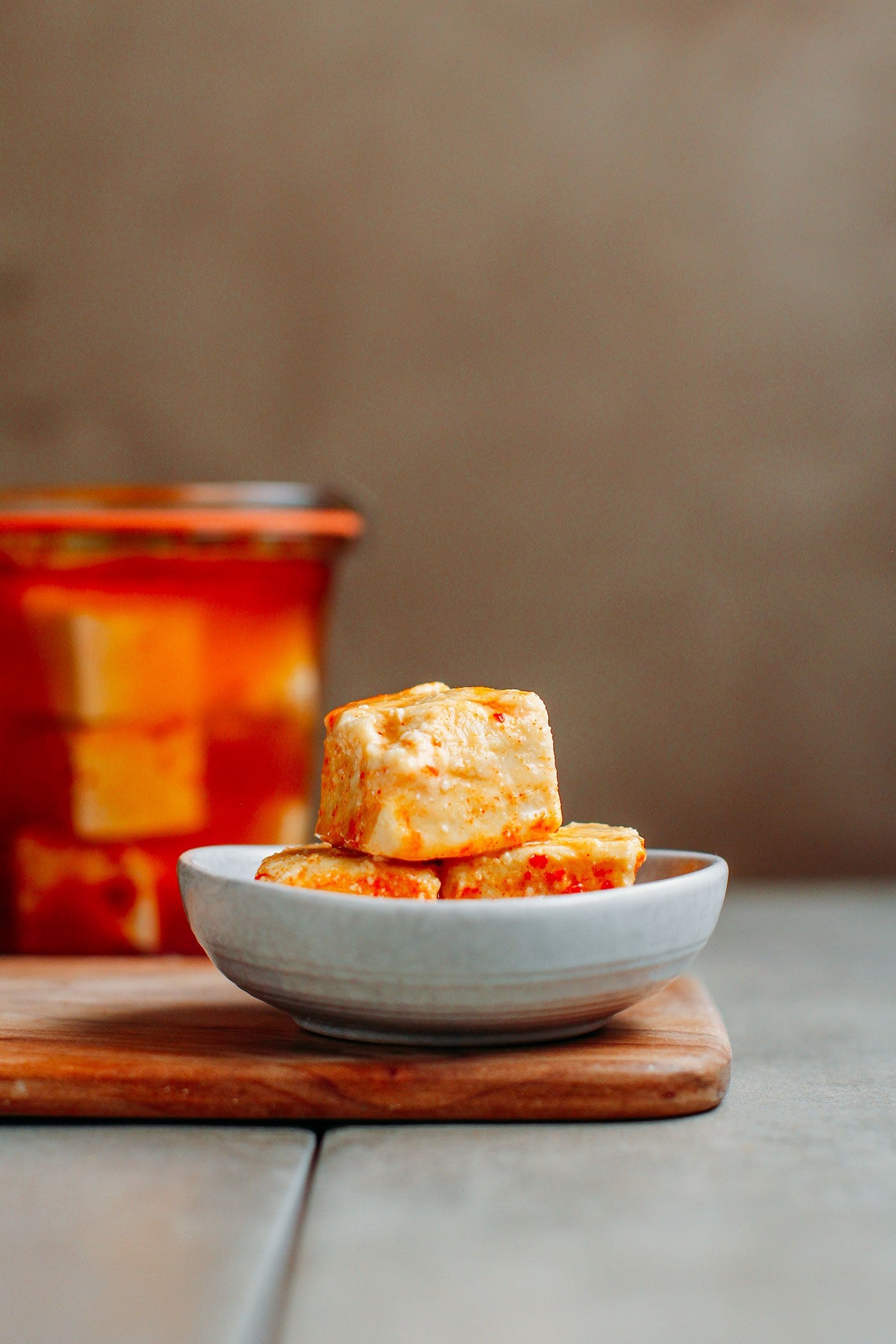

How to Make Fermented Tofu (Chao)
Ingredients
- 1 pound firm tofu cut in half
- 4 cups water
- 1 tbsp salt
- 1/4 cup chili flakes optional
Brine
- 1 and 1/2 cup water
- 3 tbsp salt
- 1 tbsp sugar
- 1/4 cup vodka (or 1/2 cup rice wine)
Instructions
- Before starting: I recommend using gloves when handling the tofu to prevent bad bacteria and mold from growing.
- Bring 4 cups of water with one tablespoon of salt to a boil in a medium-sized saucepan. Once boiling, add the tofu and boil for 4 minutes.
- Remove the tofu from the water and place it on a few sheets of kitchen paper towel. Top with more kitchen paper towel and place a heavy weight on it to press the tofu and remove excess water. I usually use an iron skillet. Let it drain for about 90 minutes, changing the paper towel as needed if it becomes too wet.
- Line a large plate with two layers of kitchen paper towel or a clean towel. Cut the tofu into 1-inch cubes and place the cubes on the plate, leaving about 1 inch between each cube, so they don't touch each other. Top with another sheet of kitchen paper towel and cover the whole plate with plastic film. The plastic film will prevent bad bacteria from reaching the tofu.
- Place the plate in a dark place at 77-86°F (25-30°C) and let it ferment for 2 to 3 days. The tofu will have taken a light orange color and will have a stinky smell. You may also see some white mold as well; this is okay. If you see blue or dark mold, scrape it off.
- Prepare the brine: combine 1 and 1/2 cups of water with the salt and sugar in a saucepan. Bring to a boil and boil for 1 minute. Once boiling, remove from heat and let it cool completely. Add the vodka and stir to combine.
- Transfer the stinky tofu to clean glass jars. If you want to make it spicy, dip each tofu cube in chili flakes before putting it in the jars. Pour the brine into the jars to cover the tofu. Close the jars with a lid and place them in a cool dark place (around 68°F – 20°C) for at least 3 weeks. The longer you let it ages, the stronger and softer your tofu will be.
- For extra flavor, you can add about 1/2 tsp of sesame oil into each jar after the 3 weeks have passed.
- Use this fermented tofu to make dipping sauces, top rice, add to vegan cheeses, and use in marinades, soups, etc.
Notes

About the Author
Thomas Pagot is the founder, photographer, and recipe developer behind Full of Plants. He created the blog in 2016 as a personal cookbook for vegan recipes. Through years of recipe development, Thomas has successfully grown Full of Plants into a trusted resource for plant-based recipes.

🧀 25 Mind-Blowing Vegan Cheese Recipes!
Sign up for the Full of Plants newsletter and you’ll get new recipes delivered by email weekly, PLUS your FREE 100-page printable eBook!



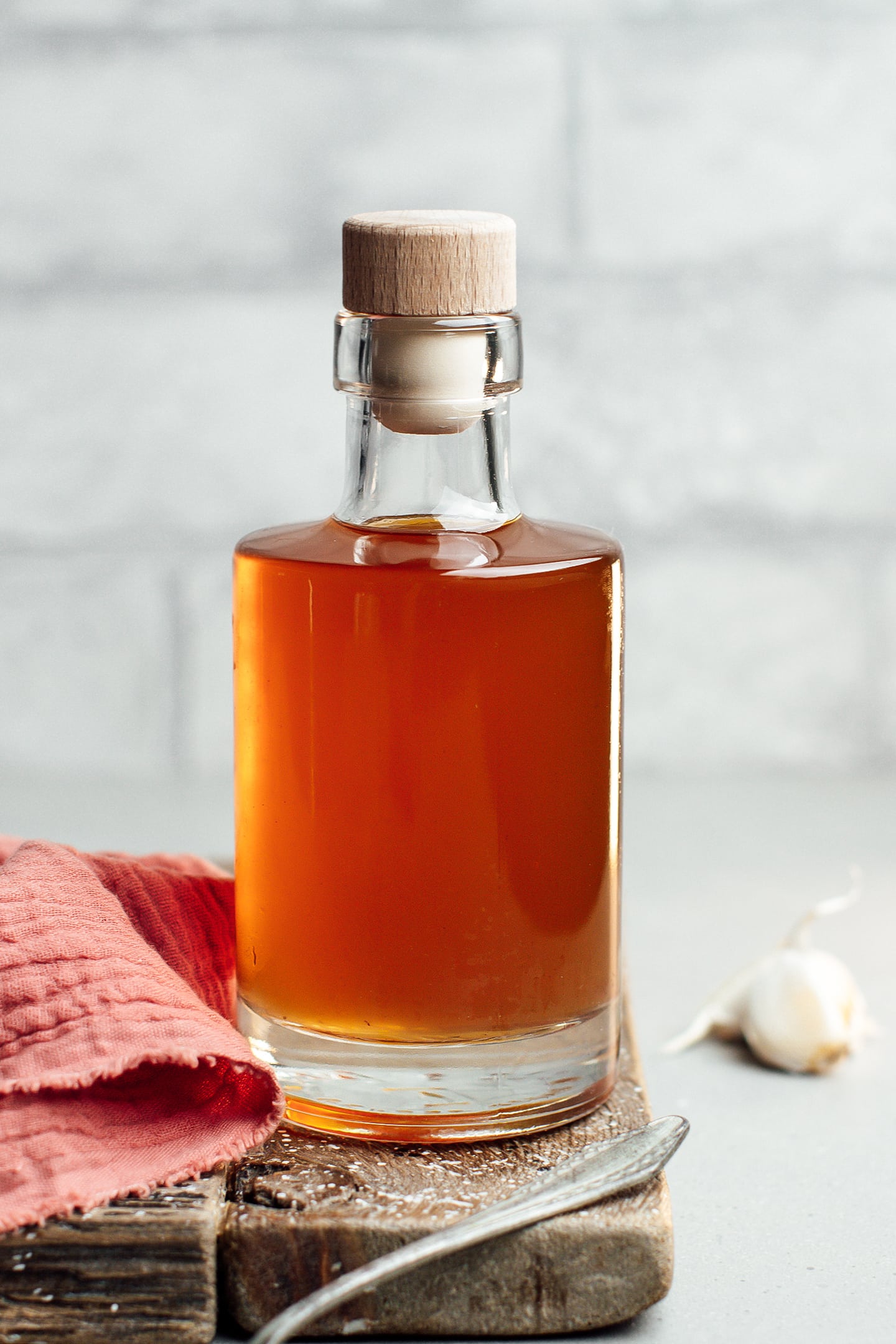
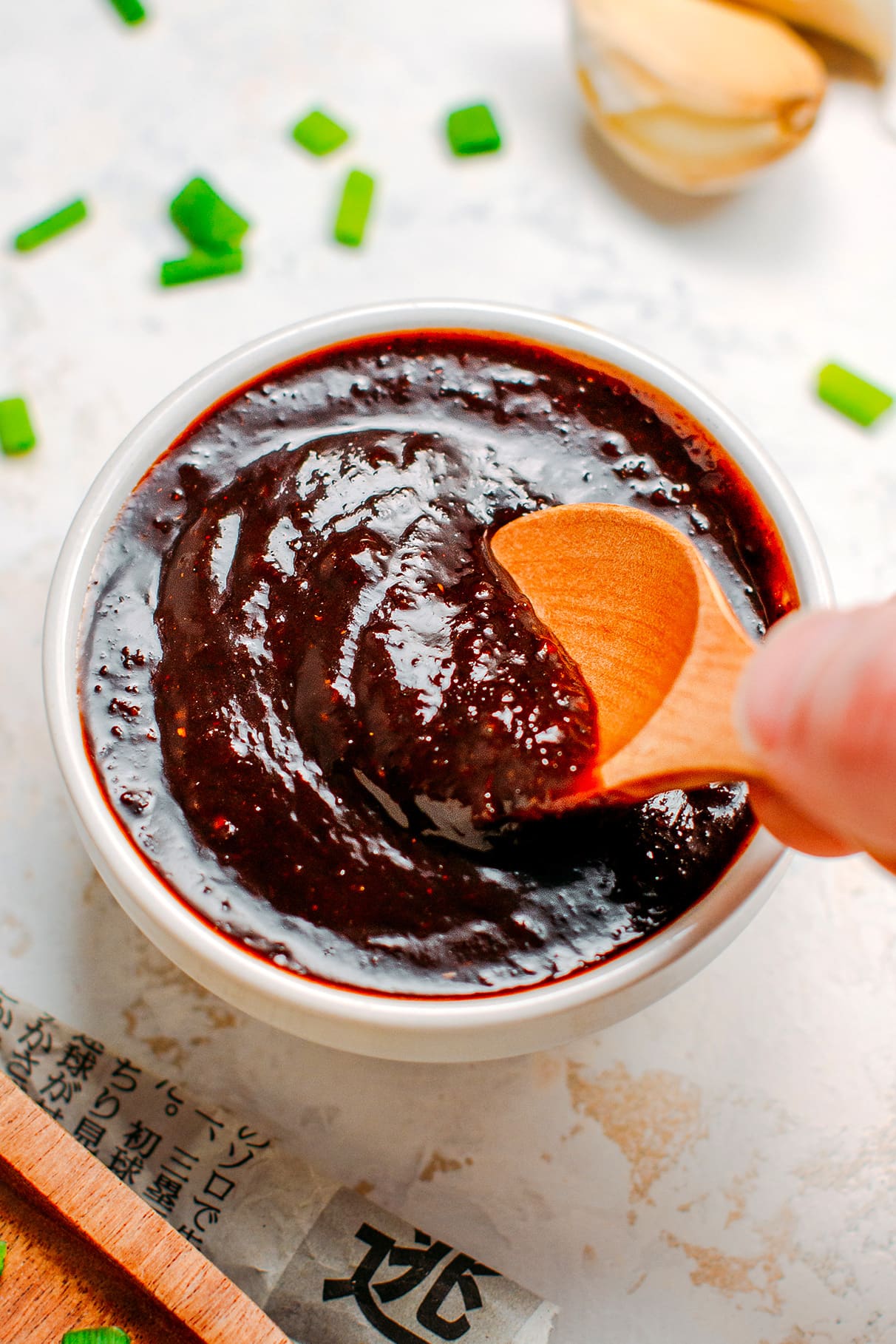
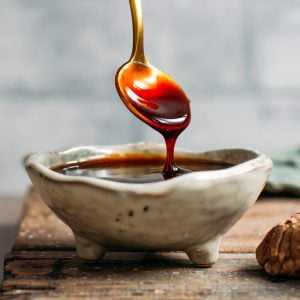
Thank you very much for this well explained guide!
I’m intrigued about fermented food and learning how to make it myself and thanks to your post I might give it a try soon!
I’ll let you know how it goes!
Have a nice day 🙂
You’re welcome Adriana!
Its amazing gave my home-made vegan cheese so much flavoir thank you Thomas
Awesome! 🙂
Hi Thomas, thank you so much for this recipe. My tofu didn’t have the orange spots after fermenting it for the first time but more of brown/red like spots. Smelled good and no black or blue. Is that still ok or should I toss it? Thank you!
I would recommend trying it again, until you get a mold similar to the one in the photos.
Hello Thomas!
I started the process, but the tofu cubes do not have any light orange color, and do not stink. The were at 30°C in the oven for 2,5 days. What do you advice? Thanks!
Thank you so much, I’ve been wanting to try this for ages! I’ll let you know how it turns out in a couple fo weeks x
Great! Good luck 🙂
I never thought of fermenting tofu before! Do you notice a difference if you let it sit for more than 2 days? Thank you for sharing!
You can let it sit up to 3 days but I would not recommend longer as bad mold may develop.
Wow you are superfast! Thank you!
Hi Thomas! Finally I got white mold on the tofu. Some with little dark spots, seamed spore. Is that ok?
Hi Zsuzsa,
You should actually see an orange tint, and not too much white mold (that’s not the goal). Regarding the dark spots, it’s not okay. If you just have a few, scrape it off, however if there is a lot of black mold you should start again.
I love fermented tofu from the jar but recently realized that it’s made of GMO soy. I’m glad I found your recipe that doesn’t use oil. I will try making it at home. Thank you!
Hope you will like the recipe!
Hi there,
The main article says to boil the tofu in salted water to start, but the recipe says just plain water. Which is it please?
Thanks very much for your help.
Hi,
That is correct, you boil the water with one tablespoon of salt. I fixed the recipe, thanks for letting me know.
Thanks, Thomas
Hi Thomas,
thank you for making this recipe, I have wanted a recipe like this for some time, thank you!
Is it possible for you to develop a cheese recipe with the chao? For example, here in Canada we can buy a cheese named “chao” that is made in Greece. This sliced cheese is very well known in North America. There are simple ingredients (i.e. the plain one). I can email you the link if you wish. Do you think you could help us with this? Thank you!
Susana
Hi Susana,
You’re welcome! I’m planning to try including a little bit of chao in cheeses to give them a deeper flavor, stay tuned!
I’m glad to hear this as I was wondering how your recipe for blue cheese would turn out adding some of this chao.
I also saw a recipe for super stretchy cheese using a bit of this chao and made with potato or tapioca starch and coconut oil. It looked like something you could try but in your way which I would love to see
AHhh, my question exactly 🙂 I have long wanted to learn how to make chao because of that cheese! I was going to ask Thomas the same thing…wouldn’t it be lovely to replicate that flavour. I will be watching for your first recipe Thomas! I dearly love and use so many of them regularly as they are spot on!
Hi Thomas,
thank you for making this recipe, I have wanted a recipe like this for some time, thank you!
Is it possible for you to develop a cheese recipe with the chao? For example, here in Canada we can buy a cheese named “chao” that is made in Greece. This sliced cheese is very well known in North America. There are simple ingredients (i.e. the plain one). I can email you the link if you wish. Do you think you could help us with this? Thank you!
Susana
I’m thinking of trying it in his fois gras recipe as well
Have you used this to make cheese?
I haven’t tried yet.
Hi,
How long can be stored, and where?
Thank you 🙂
Hi Mare,
You can store them in your refrigerator for a few months with no problem!
This is the closest thing I have ever found to a vegan Bulgarian Feta cheese. Absolutely stunning in a Greek salad with vinaigrette and oregano. Thank you!
Thanks Kelley! 🙂
I’ve been making a lot of variations of this. It’s really interesting…just like in dairy cheese making, small changes can make big differences!
I’ve found that the type of tofu makes a huge difference in texture, regardless of how long I press it. There is a bulk tofu I get from our local coop, it is with this that I make what I call the feta. The prepackaged tofu , even the kind that says extra firm, comes out as a much softer product, and ferments much faster. It reminds me of some of the true ‘’stinky’’ cheeses (washed-rind cheeses that I used to make, and loved, such as Tallegio, and even reminiscent of Epoisses! I’m truly amazed.
Also I played around with adding schezuan pepper instead of chili flakes and it is mind-blowingly good.
Some Vietnamese friends can’t believe I am making chao and they absolutely love it too.
Again, thank you!
Your comment made my day Kelley!
Yes, tofu can differ a lot depending on brands. I never buy mine at the supermarket as I find it to taste bad and has a “grainy” texture. The one I get from the Asian market is also called firm but is softer, as you said. I’m glad your Vietnamese friends like your chao 😀
That sounds really good!
Thanks a lot for this recipe, it turned out very tasty. I used some fresh red chilli slices, and the tofu turned out spicy, but very creamy, flavorful and delicious. For sure not as pretty as in your pictures though. It has a slightly grey tinge and floats, so I had to use an impromptu fermentation weight (a slightly smaller lid covered in cling foil) to keep it in the brine.
Thanks for your feedback Annika! 🙂
Hi Thomas,
thanks a lot for the recipe. I’m right now trying to work on it, but as I took the foil away today I found some white and fluffy mold and the smell is disgusting, like ammonia. Can it be that something went wrong or is it meant to be like that?
Hi Kerstin,
Which foil are you referring to? Do you mean plastic wrap?
Yes, if it smells like ammonia I would recommend starting again. Make sure everything is very clean and the temperature is not too hot.
Hi Thomas,
thanks a lot for the advice – I’ll discard and start from scratch.
(yes, I meant plastic wrap :))
Can I omit the sugar? Or use an alternative?
You may use maple syrup.
So it can’t be sugar free? Is it for taste or fermenting? Honey? Coconut blossom sugar? Agave?
I haven’t tried omitting the sugar, but I think it should work as well. The sugar helps balance a bit the flavor, it doesn’t affect the fermentation that much.
Thank you so much for this recipe, I’d really love to try it, however I don’t really drink… there’s any way to replace the vodka in the brine?
I’m afraid it will be difficult as it acts as a conservative, and helps with the fermentation as well.
Thomas, it is nice to see a recipe for this dish. One comment though: “Chao” means stinky, it does not mean “stinky tofu”. The word for tofu is pronounced “doufu”. “Chao doufu” is stinky tofu. Happy cooking!
Hi Shawn,
What I’m referring to is fermented tofu, not stinky tofu. “Chao” is the Vietnamese name for it and it doesn’t translate to stinky, it refers to this condiment.
I guess you are talking about Chinese stinky tofu that is often fried and served with a sauce. This tofu is used to make sauces and marinades, it is not eaten on its own, or fried.
Does the Chao need to be store in the refrigerator, or can it stored in a pantry? Can it be “canned” with a pressure cooker for longer storage?
Traditionally chao jar was safe to left at room temperature for months. I am a Vietnamese 🙂
Yes! 🙂
Thank you for sharing the Chao recipe. Much appreciated. I shall let you the result of my experiment.
Hope you will have success with it!
Hello Thomas,
I tired to make fermented tofu, but after one month it still has the same grainy texture. What could be the reason? Thanks!
Hello Nusha,
The main reason is that your tofu was not fermented before putting it into the brine. The fermentation is essential as it will change the texture and flavor of the tofu.
I was wondering would you still need to boil the tofu & that whole part if you are using fresh made tofu?
I make my own tofu & I’m wondering how it would work out.
Also is there anyway to make this shelf-stable?
Yes, boiling the tofu not only helps drain some water and let the salt penetrate, but it also kills possible bacterias.
It is shelf-stable for quite a long time however I prefer to keep in the refrigerator to keep longer.
I’m using & making more fermented foods these days; and added your recipe for Chao as my newest. I greatly appreciate your posting this. I had recently bought a Fermented Bean Curd at Asian Market & wonder how yours will be different. I pray you are well. Be safe.
Thanks Larry, let me know how it goes!
Hello, I have tried this twice now and each time my tofu develops a black Mold and the last batch started smelling like Ammonia. I’m not sure what I’m doing wrong. I’ve tried to keep anything g that touches the tofu clean each time. If you leave it more than 2 days, can bad bacteria infect the tofu causing my issue?
Hi David,
Sorry to hear that! At which temperature are you fermenting the tofu? Also, do you keep it covered?
Try using gloves when handling the tofu, or clean chopsticks so you don’t touch it with your hands.
Just wanted to mention again…in all the batches I have been making…the packaged tofu that is available locally is soft, even though it is called xtra firm and I press it well. This kind of tofu needs to be fermented for a much shorter time. If I let it go a full 2 days it starts to develop black mold, and the finished product is melty soft and falls apart. So I ferment it for a shorter time. Even though there isn’t much orange mold, it turns out perfect. The firmer tofu I make or buy in bulk needs a longer ferment time, or it stays hardish and grainyish for a long time. You can test a small piece as it is fermenting to see if it is getting too soft or staying too firm and adjust your ferment time accordingly. The ammonia smell seems to happen if I ferment too long….
Thanks for your input Kelley. The higher the moisture content of the tofu, the easier it is for mold (good and bad) to develop.
Thanks both Kelly and Thomas. I tried for a 3rd time and and only left covered for 2 full days. I saw a few Orange spots, but no black mold and no ammonia smell. Got it all in the brine and did a mix of as is and chilli flakes. I think you are both correct. The 2 batches that went off were left longer than 2 days. Looking forward to trying in a few weeks. Your Vegan smoked cheese looks amazing btw.
I’ve had success fermenting at 20 (68f) here in my home. It typically takes about 3 days, but it can vary. Look for light orange/yellow coloring and use the smell as a good indicator. Andrea Nguyen suggests poking few holes in the plastic wrap, but otherwise the recipe is pretty similar.
I love to spread this on home made sourdough and it is the secret ingredient in vegan mac and cheese as well as soy milk ramen. Lastly, I find the mix of gochugaru and szechuan peppercorns to be amazing.
Thanks for sharing Franklin!
In the latest batch I’m creating, I’ve noticed a few pieces with white “hairs”. It looks like the version of what is called hairy tofu. I didn’t have this result in the previous 2 batches so I’m wondering if it is OK. I think it should be since it smells OK and there are no black spots. This is about at day 2 right as the orange tint is starting to develop. Any thoughts Thomas?
As long as you don’t have too much of this hairy mold it’s okay. I also see some developing some times.
Hi Franklin, I was trying to find Andrea Nguyen’s recipe online to compare, but could not. Could you possibly share it please? 🙂 Cheers, Lee
Hi Thomas,
Thanks for sharing your recipe and technique!
I’ve been fermenting my tofu cubes for 3 weeks and the cubes are kind of breaking apart. Also on a few cubes there is a pinkish or purplish tinge…is this bad mold do you think?
Thank you!
Kieran
Hi Kieran,
You’re welcome! Tofu cubes should be very very soft and could be mashed into a smooth cream, they should not break apart too easily though.
Yes pink/purple mold is not good I’m afraid.
That was so easy and so much fun, just amazing. It lasted a long time too and provided just that extra taste to so many vegan dishes. Excellent. Loved the photography too
Awesome! Thanks for your feedback Josesphine 🙂
loved this when I ate it living in China, my father in law’s parents used to make it and I never asked them how to make it, but now I know. Thank you 😀
You’re welcome Ethan!
No airlock is used?
No need for an airlock.
Thank you! Do your readers know they can buy this, in jars, in Chinese grocery stores? If you buy it/taste it first, then you will (a) know whether you like it, (b) know what you are aiming for–what is good, and (c) what is a definite failure. (I personally think that is critical when you are trying to make something new. Especially with fermentation, the success of which will depend on what is in your air!) I have read that, in the factory where this is made in Hong Kong, they have a room that is full of the right kind of spores. They simply put racks of pressed tofu in this room for a few days, it ferments and they then bottle it. You can also taste this in some Chinese restaurants. The Taiwanese eat fermented tofu with porridge (congee). The Cantonese use it to cook certain dishes–water spinach, in particular. Actually, there are three kinds of fermented tofu: the white kind as described here; a dark red kind with a different flavor, and then a third kind that is only deep-fried in cubes–usually served as street food. You know whether the vendor is by the smell!
Very nice ,very simple. I miss the tip on what brand products i best could use like Rice wine wodka brands just because of the first try.
if the jar full of fermenting tofu shows signs of black and grey coloring …does this mean it has been contaminated and is bad?
Yes it means it went bad I’m afraid…
I’m a ferment lover always looking to new things and ways to ferment. This opens a whole new world! Oh boy, can’t wait to try it!
Congratulations, the recipe is very clear and the pictures very ilustrative. You got yourself a new follower!
Thanks for your comment Roger!
Oh, yes, I’m going to make this recipe! I occasionally buy Chao from a Chinese guy at our local farmers’ market. I just eat it with gluten free toast, and I have to be quite economical with it because for a small amount I pay around $8.00 CAN. I absolutely love it. I’m unable to consume dairy products and this is really nice and cheesy. Stinky cheesy, in the most delicious way. Thanks for demystifying it. I’d Googled it a while ago and the recipe I found made me feel that I was bound to screw up and end up with something that could give me an upset stomach. Your recipe makes me feel that I have to dash out and buy firm tofu right now! Thanks 🙂
Hi Ann,
I can guess the chao you buy tastes much better than the one sold in stores!
Good luck with chao making! 🙂